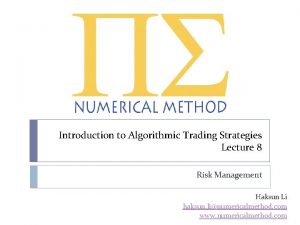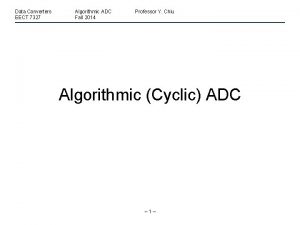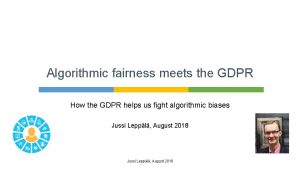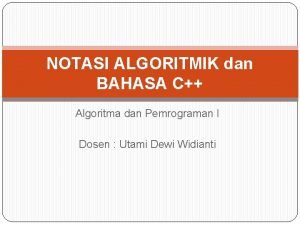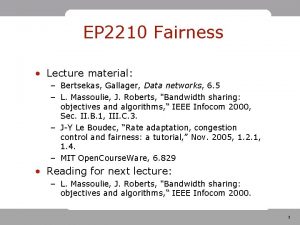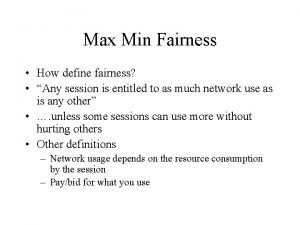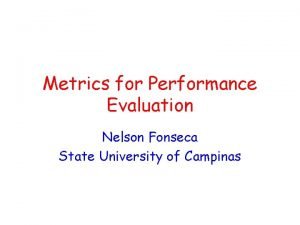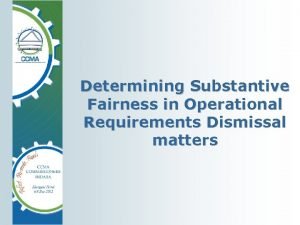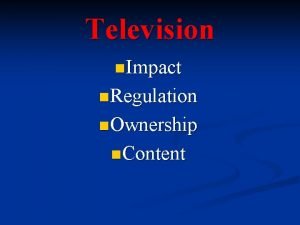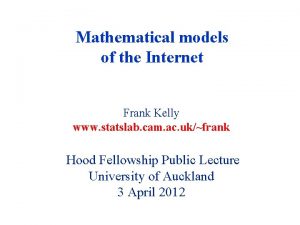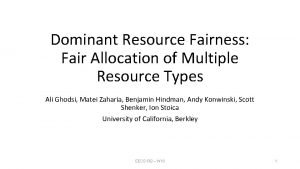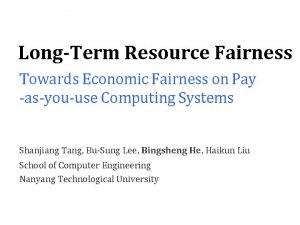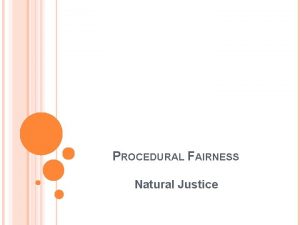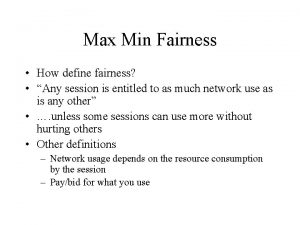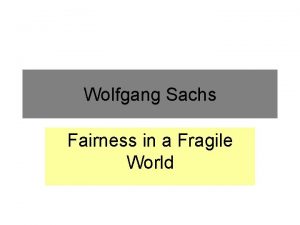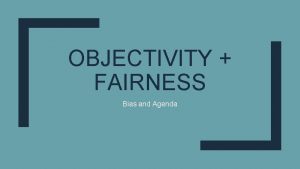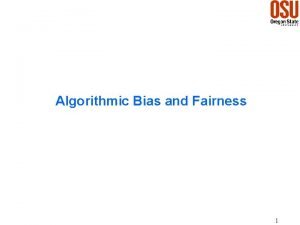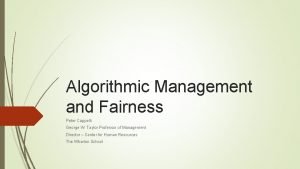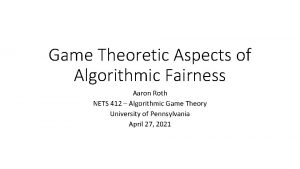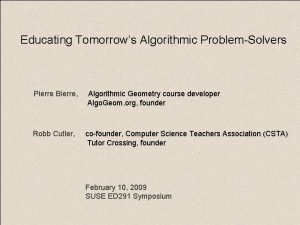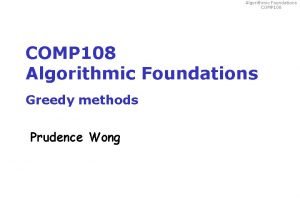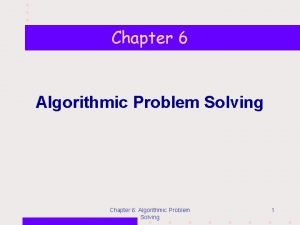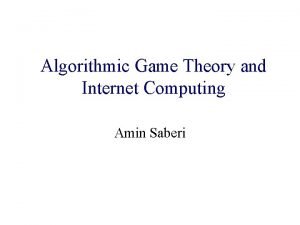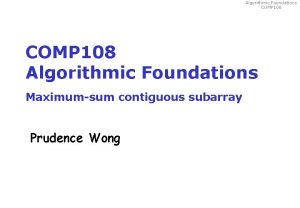Algorithmic Economic Perspectives on Fairness Cochairs David Parkes



















![Assessing Outcomes (1 of 2) • “[because of feedback loops] in addition to goodfaith Assessing Outcomes (1 of 2) • “[because of feedback loops] in addition to goodfaith](https://slidetodoc.com/presentation_image_h2/fb67536f5030111143934c380158cbbe/image-20.jpg)









- Slides: 29

Algorithmic Economic Perspectives on Fairness Co-chairs: David Parkes (Harvard), Rakesh Vohra (Penn) Task force: Liz Bradley, Sampath Kannan, Ronitt Rubinfeld, David Parkes, Suresh Venkatasubramanian 1

Participants • • • • Rediet Abebe (AI/theory) Ken Calvert (NSF) Bo Cowgill (Manag Sci) Khari Douglas (CCC) Michael Ekstrand (Rec. Sys) Sharad Goel (WWW/KDD) Lily Hu (Theory/Law) Ayelet Israeli (Manag Sci) Chris Jung (TCS) Sampath Kannan (TCS) Dan Knoepfle (Uber) Karen Levy (Law) Katrina Ligett (TCS/Econ. CS) Mike Luca (Manag Sci) Eric Mibuari (AI/Econ. CS) • • • • Mallesh Pai (Econ) David Parkes (AI/Econ. CS) John Roemer (Law/Econ) Aaron Roth (TCS/Econ. CS) Ronitt Rubinfeld (TCS) Dhruv Sharma (FDIC) Megan Stevenson (HLS) Prasanna Tambe (Manag Sci) Berk Ustun (ML/FAT*) Suresh Venkatasubramanian (TCS/FAT*) Rakesh Vohra (Econ) Hao Wang (EE) Matt Weinberg (TCS/Econ. CS) Lindsey Zuloaga (Hire. Vue) 2

• The workshop discussed methods to ensure economic fairness in a data-driven world. Participants were asked to identify and frame what they thought were the most pressing issues and to outline some concrete problems We had fun! 3

4

5

6

7

8

9

We wrote a report! 10

Background Context • Algorithmic systems have been used to inform consequential decisions for at least a century. Recidivism prediction dates back to the 1920 s. Automated credit scoring dates began in the middle of the last century. So what is new here? 11

• Scale for one. – Algorithms are being implemented precisely so as to scale up the number of instances a human decision maker can handle. Errors that once might have been idiosyncratic become systematic. • Ubiquity, is also novel – Success in one context begets usage in other domains. Credit scores, for example, are used in contexts well beyond what their inventors imagined. • Accountability must be considered. – Who is responsible for an algorithm’s predictions? How might one appeal against an algorithm? How does one ask an algorithm to consider additional information beyond what its designers fixed upon? 12

Four Framing Remarks • One: The equity principle for evaluating outcomes • Circumstances, factors beyond an individual’s control, such as race, height, and social origin • Effort variables, factors for which individuals are assumed to be responsible. • Inequalities due to circumstances holding other factors fixed are viewed as unacceptable and therefore justify interventions. 13

Four Framing Remarks • Two: Taste-based vs Statistical discrimination • Taste-based: discriminates against an otherwise qualified agent as a matter of taste alone • Statistical: unconcerned with demographics per se, but understands that demographics are correlated with fitness for task 14

Four Framing Remarks • Two: Taste-based vs Statistical discrimination • Taste-based: discriminates against an otherwise qualified agent as a matter of taste alone • Statistical: unconcerned with demographics per se, but understands that demographics are correlated with fitness for task • Becker (1957): taste-based discrimination is attenuated by competition between decision makers with heterogeneity in taste. • Policies to reduce statistical discrimination are 15 less well understood.

Four Framing Remarks • Three: Emergence of Fair machine learning research • Goal is to ensure that decisions guided by algorithms are equitable. • Over the last several years, myriad formal definitions of fairness have been proposed and studied. 16

Four Framing Remarks • Four: Mitigating data biases • Statistical ML relies on training data, which implicitly encodes the choices of algorithm designers and other decision makers. • Can be a dearth of representative training data across subgroups • Target of prediction may be a poor — and potentially biased — proxy of underlying act • Amplification: When training data are the product of ongoing algorithmic decisions, feedback loops 17

Report Structure 1. 2. 3. 4. 5. 6. 7. Overview Decision Making And Algorithms Assessing Outcomes Regulation and Monitoring Educational and Workforce Implications Algorithm Research Broader Considerations What did we say? !! 18

Decision Making And Algorithms • “At present, the technical literature focuses on ‘fairness’ at the algorithmic level. The algorithm’s output, however, is but one among many inputs to a human decision maker. Therefore, unless the decision maker strictly follows the recommendation of the algorithm, any fairness requirements satisfied by the algorithm’s output need not be satisfied by the actual decisions. ” 19
![Assessing Outcomes 1 of 2 because of feedback loops in addition to goodfaith Assessing Outcomes (1 of 2) • “[because of feedback loops] in addition to goodfaith](https://slidetodoc.com/presentation_image_h2/fb67536f5030111143934c380158cbbe/image-20.jpg)
Assessing Outcomes (1 of 2) • “[because of feedback loops] in addition to goodfaith guardrails based on expected effects, one should also monitor and evaluate outcomes. Thus, providing ex ante predictions is no less important than ex post evaluations for situations with feedback loops. ” 20

Assessing Outcomes (2 of 2) • “… a fundamental tension between attractive fairness properties… Someone’s notion of fairness will be violated and tradeoffs need to be made. . . These results do not negate the need for improved algorithms. On the contrary, they underscore the need for informed discussion about fairness criteria and algorithmic approaches, tailored to a given domain. 21

Assessing Outcomes (2 of 2) • “… a fundamental tension between attractive fairness properties… Someone’s notion of fairness will be violated and tradeoffs need to be made. . . These results do not negate the need for improved algorithms. On the contrary, they underscore the need for informed discussion about fairness criteria and algorithmic approaches, tailored to a given domain. Also, these impossibility results are not about algorithms, per se. Rather, they describe a feature of any decision process, including one that is executed entirely by humans. ” 22

Regulation and Monitoring (1 of 2) • “Effective regulation requires the ability to observe the behavior of algorithmic systems, including decentralized systems involving algorithms and people. … facilitates evaluation, improvement (including “de-biasing”), and auditing. … [but] transparency can conflict with privacy considerations, hinder innovation, and otherwise change behavior. 23

Regulation and Monitoring (2 of 2) • “Effective regulation requires the ability to observe the behavior of algorithmic systems, including decentralized systems involving algorithms and people. … facilitates evaluation, improvement (including “de-biasing”), and auditing. … [but] transparency can conflict with privacy considerations, hinder innovation, and otherwise change behavior. Another challenge is that the disruption of traditional organizational forms by platforms (e. g. , taxis, hotels, headhunting firms) has dispersed decision making. Who is responsible for ensuring compliance on these platforms, and how can this be achieved? ” 24

Educational and Workforce Implications • “What should judges know about machine learning and statistics? What should software engineers learn about ethical implications of their technologies in various applications? There also implications for the interdisciplinarity of experts needed to guide this issue (e. g. , in setting a research agenda). What is the relationship between domain and technical expertise in thinking about these issues? How should domain expertise and technical expertise be organized: within the same person or across several different experts? ” 25

Algorithms Research • “. . . a lot of work is happening around the various concrete definitions that have been proposed — even though practitioners may find some or even much of this theoretical algorithmic work misguided. 26

Algorithms Research • “. . . a lot of work is happening around the various concrete definitions that have been proposed — even though practitioners may find some or even much of this theoretical algorithmic work misguided. How to promote cross-field conversations so that researchers with both domain (moral philosophy, economics, sociology, legal scholarship) and technical expertise can help others to find the right way to think about different properties, and even identify if there are dozens of properties whose desirability is not unanimously agreed upon? ” 27

Broader Considerations • “some discussion went to concerns about academic credit and how the status quo may guide away from applied work, noting also that the context of more applied work can be helpful in attracting more diverse students 28

Broader Considerations • “some discussion went to concerns about academic credit and how the status quo may guide away from applied work, noting also that the context of more applied work can be helpful in attracting more diverse students … the research community may ‘narrow frame’ the issues under consideration. e. g. , selecting from applicants those most qualified to perform a certain function is not the same as guaranteeing that the applicant pool includes those who might otherwise be too disadvantaged to compete. ” 29
 Parkes plastic bags
Parkes plastic bags Miles parkes
Miles parkes Parkes observatory tours
Parkes observatory tours Dr peter parkes
Dr peter parkes Ireallytrade
Ireallytrade Algorithmic nuggets in content delivery
Algorithmic nuggets in content delivery Algorithmic state machine examples
Algorithmic state machine examples Introduction to algorithmic trading strategies
Introduction to algorithmic trading strategies Algorithmic trading singapore
Algorithmic trading singapore Algorithmic adc
Algorithmic adc Algorithmic cost modelling
Algorithmic cost modelling Gdpr algorithmic bias
Gdpr algorithmic bias Introduction to algorithmic trading strategies
Introduction to algorithmic trading strategies An asm chart of mealy model
An asm chart of mealy model Kalman filter trading strategy
Kalman filter trading strategy Algorithmic graph theory and perfect graphs
Algorithmic graph theory and perfect graphs Algorithm input, output example
Algorithm input, output example Algorithmic thinking gcse
Algorithmic thinking gcse Winperl
Winperl Algoritma adalah
Algoritma adalah Introduction to algorithmic trading strategies
Introduction to algorithmic trading strategies Max-min fairness
Max-min fairness Max-min fairness example
Max-min fairness example Fairness
Fairness Avoiding discrimination through causal reasoning
Avoiding discrimination through causal reasoning Substantive fairness
Substantive fairness Orientation in space and time global context
Orientation in space and time global context The fairness doctrine
The fairness doctrine Fairness
Fairness Dominant resource fairness
Dominant resource fairness







